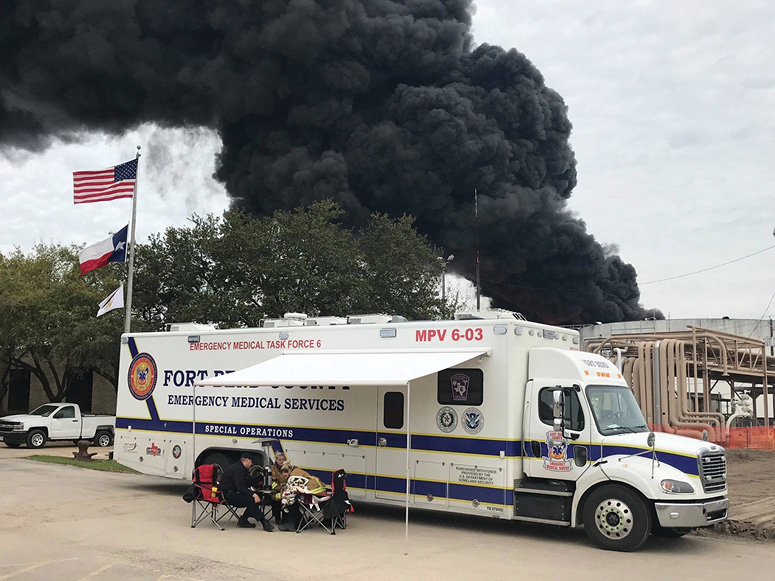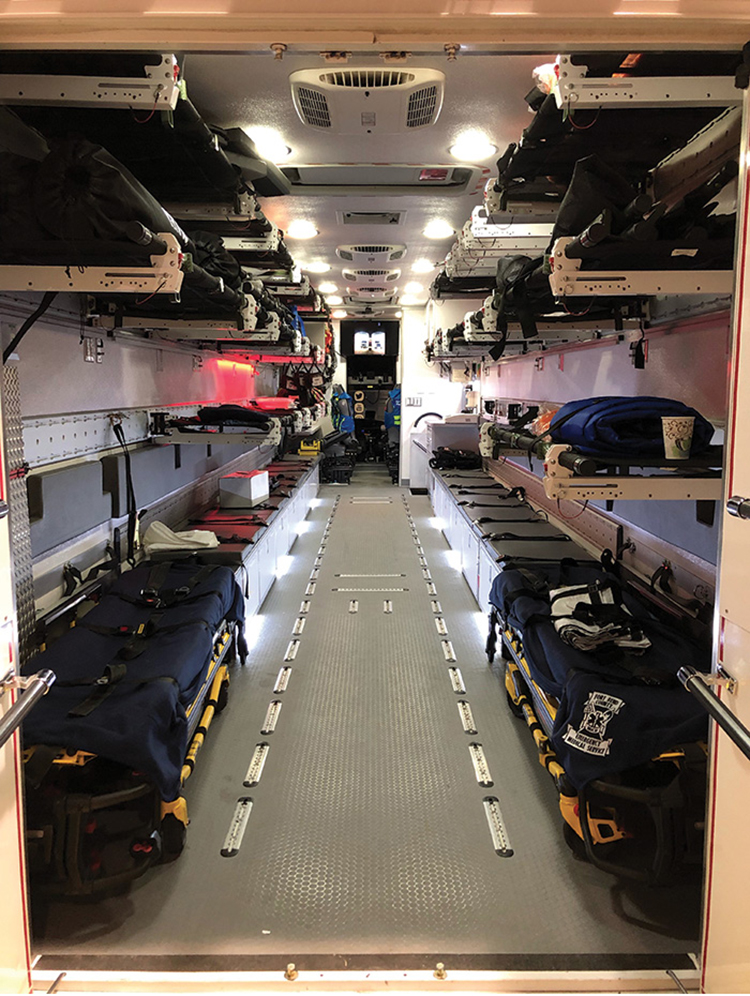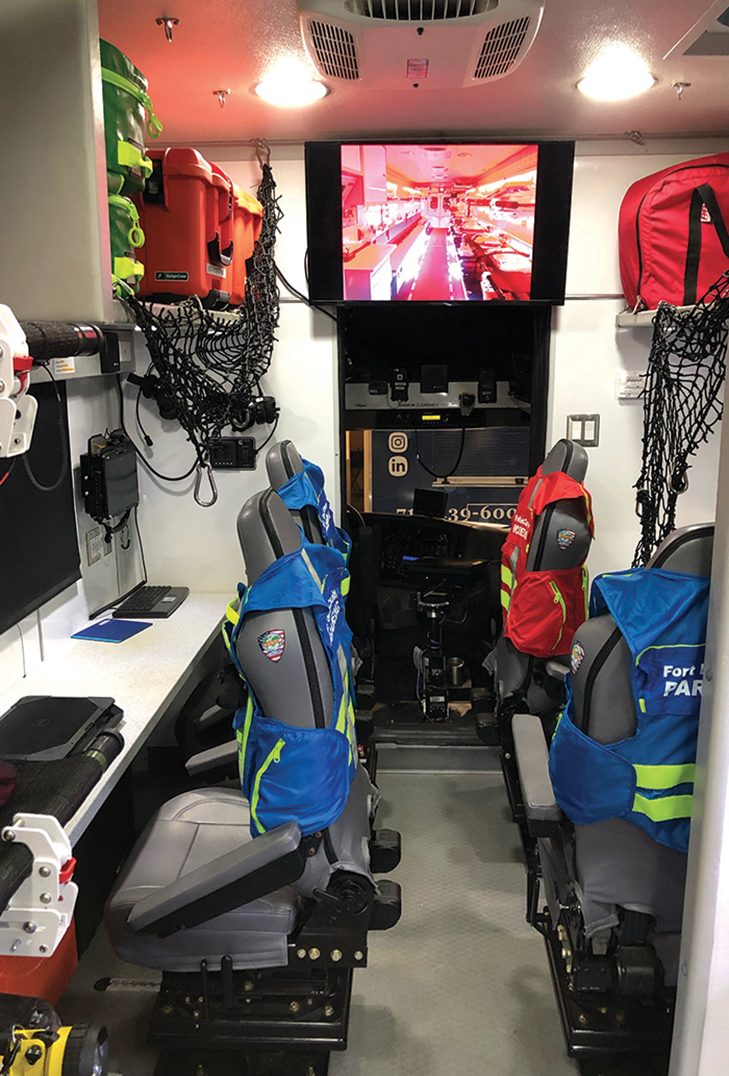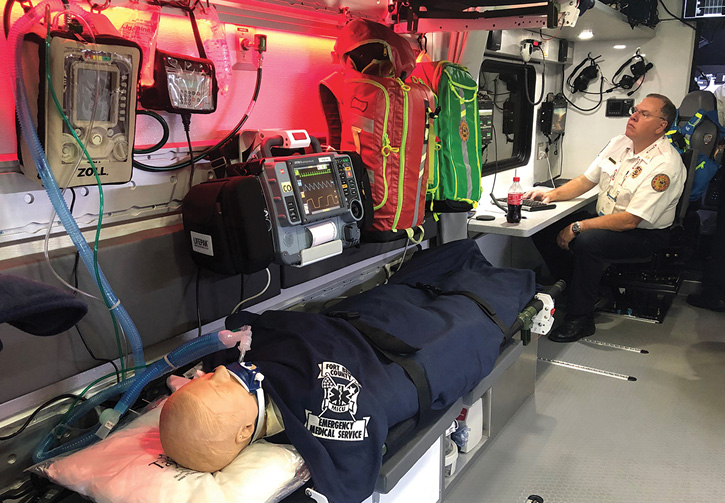
BY ED BALLAM
One of the fundamental keys to effective responses during times of disaster is having the right resources readily available. And, that’s the exact mission of General Truck Body’s Multi Patient Vehicle (MPV)—to provide rapid transport of large numbers of casualties from man-made or natural disasters.
The MPV is designed to “assist in the response of multiple personnel events either by accidental, transfer, or recovery of people in disasters,” according to the manufacturer, based in Houston, Texas.
Related: Vehicles for Complex Emergency Incidents
General Truck Body’s new apparatus is a dramatic improvement over medical ambulance buses, known by first responders as AMBUS, according to Jim Braden, the company’s vice president of engineering. The MPV can transport up to 20 littered patients, 25 seated patients, or a combination of both, depending how the body is configured for the mission. “What occurred in the past was a multicasualty unit based on a school bus chassis,” Braden says, noting that there are still lots of AMBUS vehicles in service. He explained that the Texas Emergency Medical Task Force was looking to replace the school-bus-based vehicles with something more suited to the state’s needs. “We were contacted because of our initial product we put out for the Department of Defense, which was a patient evacuation vehicle,” Braden says. Those vehicles, he explains, transported wounded military personnel hurt in overseas theaters of war from Andrews Air Force Base, in the Washington, D.C., area, to Walter Reed National Military Medical Center in Bethesda, Maryland. “Back in 2008, we built three of those units and replaced basically 14 school buses,” Braden says.
Unlike the AMBUS vehicles, MPV vehicles are built on Freightliner cabs and chassis with cutaway cabs that provide access to custom-made box-style bodies. The MPV design provides more room than school-bus-based patient transport, which can be configured to fulfill a variety of patient transport need, from seated “walking wounded” to bariatric patients in hospital beds with an array of pumps and equipment.

1 The MPV can transport up to 20 littered patients, 25 seated patients, or a combination of both, depending how the body is configured for the mission. Shown here is the MPV built for Fort Bend County, Texas. (Photos courtesy of General Truck Body.)
The MPV can also be used for other missions, including first responder rehab at large incidents; command center functions; and a standby hospital/medical facility for Spring Break activities on South Padre Island, Texas.
It was that versatility that attracted Brian Petrilla, assistant chief of EMS with Fort Bend County, Texas. His agency was instrumental in the design of the MPV unit and took delivery of one in February 2019.
FORT BEND COUNTY NEEDS
Petrilla says his agency participated in a national tabletop exercise for a natural disaster when the need for an AMBUS-type vehicle was discussed. “I said there was an absolute need for one not only in our county but in our region,” Petrilla says. “There’s really nothing south of Houston, and the closest one was six or eight hours away. That’s where it all started.”
From that initial discussion, Petrilla says the county started looking for grant money to purchase a multipatient vehicle. It applied for and was awarded an Urban Areas Security Initiative (UASI) grant, a program that provides money for high-threat, high-density urban areas to help mitigate and recover from acts of terrorism.
With the grant secured, Petrilla says the county started looking for a vendor to build one. The company building AMBUS vehicles had closed, so he started to talk to state authorities looking for a company to build something to meet the needs of Fort Bend County. Petrilla learned about the Texas Emergency Medical Task Force committee that was also looking for AMBUS-vehicle replacements. “I got on that committee, and we got all the AMBUS owners in the state together, and we started talking about the core mission and what were the capabilities and what they could and could not do,” Petrilla says.

2 A large, bifold ramp with detachable hand rails stowed in between the rear truck frame rails provides access to an oversized rear door. A special transition plate bridges the apparatus and facility loading docks to make it easier to load entire hospital beds into the rear of the unit.

3 The body interiors feature ample storage, which is placed wherever practical and accessible. For instance, there’s storage under the bench seats, which run nearly the entire length of the apparatus on each side and serve as space for litters. It also has exterior storage and secured storage for narcotics.
The limitations of the AMBUS were readily identifiable, and the committee started looking at building a new vehicle around the core mission as well as other potential missions and figuring out a way to do them more easily, Petrilla says.
Once the committee decided the vehicle’s missions, a request for quotation was released, and General Truck Body won the award, Petrilla says, adding that the committee started working on the “design/build” project to come up with the vehicle most suited to the needs. “We decided we didn’t want to put it on a bus chassis because we had so many issues with them,” he says. “That’s when we came up with the box placed on the back of a truck.” Fort Bend County decided to use an over-the-road 18-wheeler Freightliner cab and chassis with a stretched frame and a custom-built box on the back.
THE TRUCK BUILD
Braden says the Freightliner cab and chassis was selected not only for its reliability and capabilities but because Freightliner allowed General to build a cutaway cab to attach to the custom body. The Freightliner cabs also provide suitable drivetrains for the vehicle, Braden says, noting that the minimum engine size should be no less than 350 horsepower (hp) while 500 hp will provide a more robust apparatus capable of moving patients quickly with plenty of power.
The MPV is also scalable to the customer’s needs, says Chris Maikranz, General Truck Body’s director, First Responder Division. He added the MPV can be built on a Ford F-550 or F-650 cab and chassis for customers who don’t need the capacity the Freightliner unit offers. Braden says some areas can’t handle 40-foot-long vehicles, like the mountainous roads in Colorado.

4 The Fort Bend County unit has four operators’ stations in the front, and those seats can be moved to patient care areas as needed. The interior wall coverings and cabinets can be aluminum plate; fiberglass; and, in some cases, plywood so tools and equipment can be mounted for storage.

5 A strut system on the interior of the apparatus allows for “on-the-fly” reconfiguration with litter arms that can be installed and removed as necessary.

6 The interior of the Fort Bend County, Texas, MPV during a multicasualty incident demo.
The body is constructed of a welded aluminum frame with aluminum sheet and custom extrusions, Braden says. And, because the body is essentially a box, it offers far more interior space than a school bus-based vehicle. He added that, unlike a school bus body, the MPV body can be transferred to a new cab and chassis in the future, as necessary, if the running gear wears out or is damaged. “The school bus design had two faults,” Braden says. “One, it was extremely high and, two, if you lost any portion of the bus itself, or any portion of the interior, you’ve lost the entire vehicle.” He says the MPV is a vast improvement as the body is welded with custom frame works. So confident of the design, Braden says General Truck Body has lifetime guarantees on the MPV structure.
The MPVs are equipped with several redundant systems when it comes to life-sustaining equipment. Braden says the MPV is equipped with a total of six Size H oxygen bottles, three on each side, which alternate side-to-side as necessary, much like a breathing air cascade system. The 2,500-pound-per-square-inch bottles have regulators that step down pressure to the appropriate level to usable levels accessible at standard hospital wall outlets inside the truck body.
The body interiors also feature ample storage, which is placed wherever practical and accessible. For instance, Maikranz says there’s storage under the bench seats, which run nearly the entire length of the apparatus on each side and serve as space for litters. It also has exterior storage and secured storage for narcotics. “There’s not a patient or passenger or operator’s seat without storage in it,” Maikranz says, adding that some of the seating is apparatus-grade made by H.O. Bostrom.
In the Fort Bend County unit, there are four operators’ stations in the front, and those seats can be moved to patient care areas as needed. The interior wall coverings and cabinets can be aluminum plate; fiberglass; and, in some cases, plywood so tools and equipment can be mounted for storage, Braden says.
The interior also features DuPont countertops that are durable and stain-resistant, Braden says, noting that heavy vinyl padding and coverings are also used where appropriate. Braden says there are also redundant power supplies, which include a 30-kW generator powered by a Kubota diesel engine supplied by fuel from the apparatus’s onboard fuel tank. He says the MPV, in standby mode, can power the unit’s five air-conditioning units rated at 15,000 Btu hours and five heaters rated at 6,000 Btu hours. The power system can also provide shore power for up to five ambulances in standby mode via outside connections. “And, we can do that for an extended amount of time,” Braden says.
Helping to keep power demand lower, General Truck Body uses all LED lights, including white and red lights for interior lighting, Braden says, adding that each litter area has individual lighting for patient comfort.
Warning lights are provided by Whelen Engineering, Braden says, noting that Code 3 and Tomar warning lights can also be used depending on customer preference. Scene lighting, which can be flush-mounted or recessed on the exterior of the body, is provided by FRC, he says.
General Truck Body has large paint booths, up to 60 feet long, 40 feet wide, and 40 feet high, so painting the MPV apparatus is not a problem, Braden says, adding that the company generally uses Sikkens paint system as well as Sherwin Williams systems. The company also can provide body wraps to the customers’ wishes, using a third-party vendor that does the work on site.
A strut system on the interior of the apparatus allows for “on-the-fly” reconfiguration with litter arms that can be installed and removed as necessary. A large, bifold ramp with detachable handrails stowed in between the rear truck frame rails provides access to an oversized rear door. A special transition plate bridges the apparatus and facility loading docks to make it easier to load entire hospital beds into the rear of the unit. A 3,000-pound winch, with a special purchase point inside the apparatus, helps with the loading of bariatric patients. “We can roll patients into the back of the [unit] without having to take the patient out of the bed and put him onto an ambulance stretcher,” Petrilla says, adding that’s a feature AMBUS units could never dream of providing.
EVOLVING CAPABILITIES
Braden says MPV units can also be fitted with Stryker ambulance cots, power and manual, depending on the customers’ preferences. “That gives the unit some quick-response capabilities as well,” Braden says. “We’re still learning about its capabilities, and some of these guys are very creative. They come up with ways to overcome just about anything and are coming up with things we haven’t even thought about.” Maikranz adds, “They adapt, adjust, and overcome.”
And, that’s what Petrilla has been doing since he took delivery of the unit. It has been used on large tank fires for firefighter rehab, served as a medical outpost for Spring Break activities in his coverage area, and was used to evacuate a nursing home during flooding from Tropical Storm Imelda that hit in September 2019. “We’re on the Gulf Coast, so it’s not new to us to see a hurricane once in a while going through here,” Petrilla says. “It’s like, ‘Is it going to snow in New York?’ ”
When Hurricane Harvey hit the area in 2017, Petrilla says his agency evacuated three of the four hospitals in the county, and the MPV would have been perfect.
Petrilla says his coverage area also has U.S. 69 running all the way through the county to Mexico with lots of buses and trucks as well as an Amtrak line creating lots of possibilities for mass casualty situations. The assistant chief says in those situations, the MPV will help him keep ambulances in service in the coverage area rather than stripping the agency of all available ambulances, leaving resources available to cover other calls.
The MPV also responds on all hazmat calls, giving personnel a place to don gear out of the heat. “I get an extra 20-plus minutes of work out of them because they are not starting off hot,” Petrilla says.
The manufacturer says the MPV has potential need nationwide. “It can be used in any large, metropolitan area, like Houston, New York, Chicago, L.A., places with high-density populations,” Maikranz says. “It can be used anywhere there could be potential for large natural disasters like hurricanes, tornadoes, flooding, multi-car accidents.” He adds that it can also be used a multiple-alarm fires and large events. “It’s a very versatile, easily configurable unit.”
ED BALLAM is the assistant chief of the Haverhill Corner (NH) Fire Department and a National Registered EMT. He is also a deputy forest fire warden for the New Hampshire Division of Forests and Lands. He’s been a journalist for more than 35 years, working for a variety of publications, including employment as managing editor of a national fire service trade journal for more than a decade.

